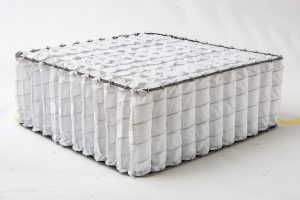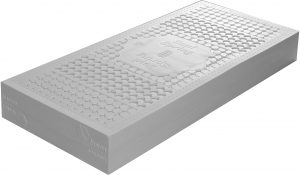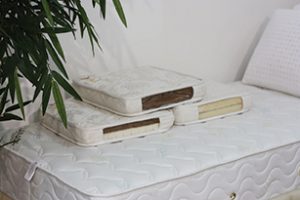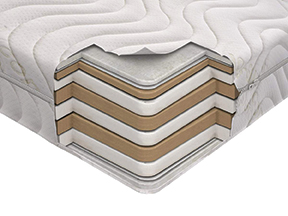Depending on what type of bed you have, a box spring can either help or hurt your mattress. Use this guide to make your decision.
Designed to support a mattress, a box spring consists of a wood frame filled with either springs or a metal grid. The box spring is encased in fabric and placed beneath the mattress on a bed frame. Some also have supportive slats on the bottom. They’re made to match the sizes of most traditional mattresses, from twin to king. 
Once commonly sold as an integral part of traditional innerspring mattress sets, box springs served several purposes until recent innovations began limiting their usefulness. Such purposes include:
- Adding support to the mattress
- Extending the mattress’s longevity
- Lifting the mattress higher so sleepers can more easily get in and out of bed
- Absorbing impact in order to protect the mattress and reduce wear and tear
- Improving breathability and airflow to help sleepers feel cool
- Helping to prevent mold and mildewgrowth outside the mattress
While many new mattresses do not require or work well with box springs, some still do. Other brands recommend them, but only if a metal frame is used. Still more suggest the use of a different type of bed frame or foundation altogether with their mattresses. We’ll go over who does and doesn’t need a box spring, and how to make sure you’re not using the wrong base for your mattress.
When to skip the box spring
Many of today’s modern, bed-in-a-box mattresses are made either all or partially of memory foam or latex foam. It’s typically recommended to skip the box spring when setting these up, foam mattress brand Casper explains, because “the slats on older box springs are too [far] apart to support the weight of a foam mattress, and that lack of support can cause it to sag.” Instead, the company suggests a platform with slats closer together. Eco-friendly mattress brand Avocado Green also advises strongly against using box springs with its hybrid and latex mattresses, recommending firmer, sturdier foundations instead.
Read more: Why you shouldn’t use a box spring with a foam mattress
Check with your mattress brand
On the other hand, there are some exceptions. Modern mattress brand Saatva suggests that box springs may be used with its mattresses if the box spring is less than 7 years old and has proper center support and the slats are less than 4 inches apart. Helix also approves box springs with its mattresses, but only if slats are less than 5 inches apart and a piece of plywood or other proper center support is added.
Since there’s some variation across brands here, it’s best to check with customer support to find out your own mattress brand’s advice.
It’s also important to do research on the warranty for your mattress. This information can be found on the website of the mattress manufacturer or retailer, or on the tag attached to the mattress. Follow the manufacturer’s instructions so you won’t end up voiding the warranty by using the wrong type of foundation or frame with your mattress.
Some brands make their own box spring alternatives
Some companies are creating their own alternatives to box springs. Casper makes a “box spring alternative” called The Foundation that works with its foam mattresses, while GhostBed sells a box spring/metal frame/foundation combo called the All-in-One Foundation. Brooklyn Bedding creates a Ready-To-Assemble Box Foundation that looks and feels like a traditional box spring with the added center support box springs typically lack. Tuft & Needle also makes its own version called the Box Foundation, a product which its site refers to as an upgraded box spring.

One benefit to buying a box spring alternative directly from your mattress company is that you don’t have to worry about whether or not it’s compatible. While some companies recommend using the foundations or bases they manufacture themselves, others suggest that anything sturdy will work, from a box spring to a wooden frame to the floor itself. Again, to know for sure, check the fine print on your mattress.
Who should still use a box spring?
A box spring should still be used under a few circumstances, such as:
- If you have a traditional innerspring mattress.
- If you have a metal bed frame.
- If you have trouble getting into or out of bed, and raising the mattress height helps.
- If your mattress warranty indicates a box spring is advised.
Alternatives to the box spring
There are several alternatives you can choose from, with something ideal for every mattress type.
Platform beds
These serve as both a frame and foundation, providing stability and support while keeping the mattress elevated off the ground. They tend to be easy to assemble and can support heavier mattresses, and some include features like drawers or other similar small storage spaces. They can also be quite a bit more expensive than other options. 
Foundation
These are typically designed to be used with bed frames, but some are made for use on their own as well. They provide a sturdy, firm surface to place your mattress on, an ideal option for memory foam beds. They’re often made up of wooden slats or solid wood frames.
Adjustable bed
These are bed frames that can be adjusted into numerous different positions, helpful for those who like to change their sleep position frequently or who have trouble with pain, acid reflux, poor circulation or snoring. These mattresses can be highly customizable, and some even come with remote controls to customize each side of the bed. They can only be used with mattresses made specifically for adjustable beds, or those that are flexible enough to work with them. Expect these to be pricier than most other options.
Bunkie board
This is a hearty slab of wood that adds support to bunk beds, pull-out sofas and other sleep options that lack firmness and support, especially in the center. It can be taken apart between uses and stashed away until next time.
Wooden slat bed supports
These are sets of wooden slats arranged for optimal ventilation on a platform. They’re usually supportive for heavy mattresses, noise-free and offer a remarkable amount of space underneath for storage. They aren’t too pricey and work as a great budget option for those who find full frames too expensive. 
Bed on the floor
Some swear sleeping on the floor helps alleviate back pain better than any other remedies they’ve tried — so why not try a mattress directly on the floor? After all, many of today’s mattresses are firm and dense enough to place on the floor without the need for any additional support from a platform or foundation at all. This idea also works with minimalist decor and a simple budget.
 SleepTech Magazine Mattress, Accessories, Machinery, Raw Materials
SleepTech Magazine Mattress, Accessories, Machinery, Raw Materials



